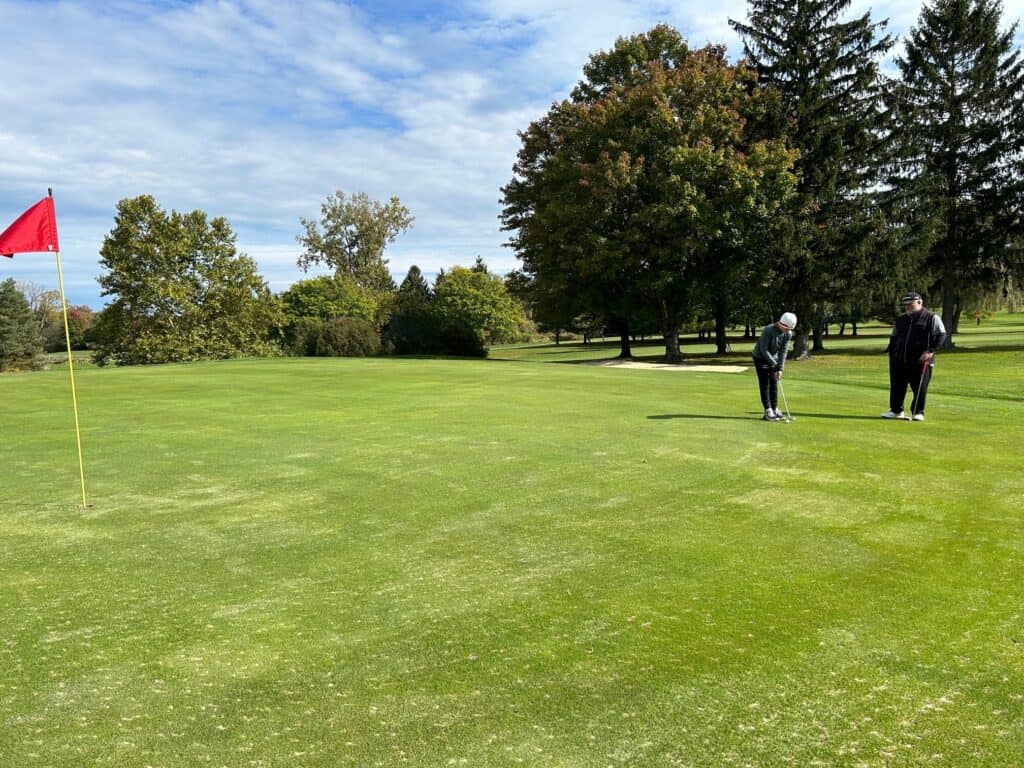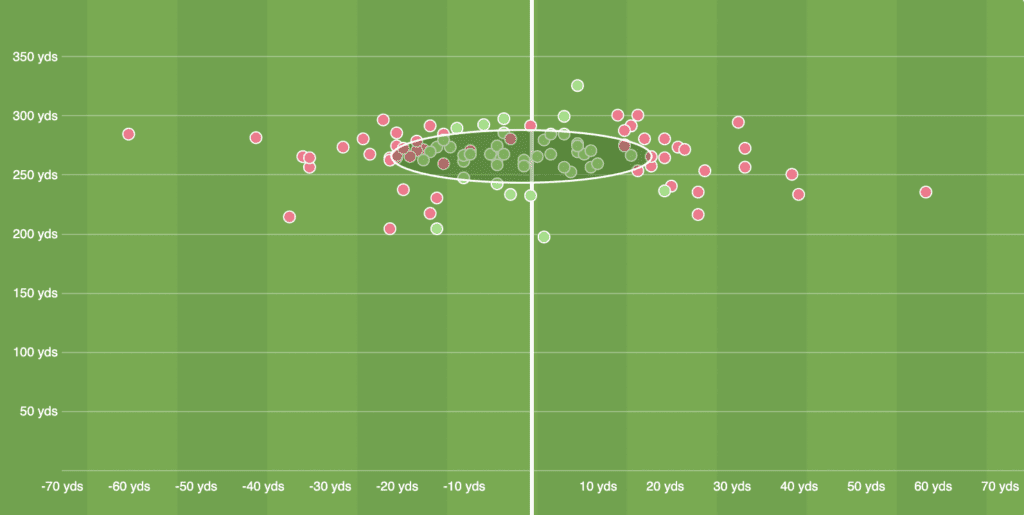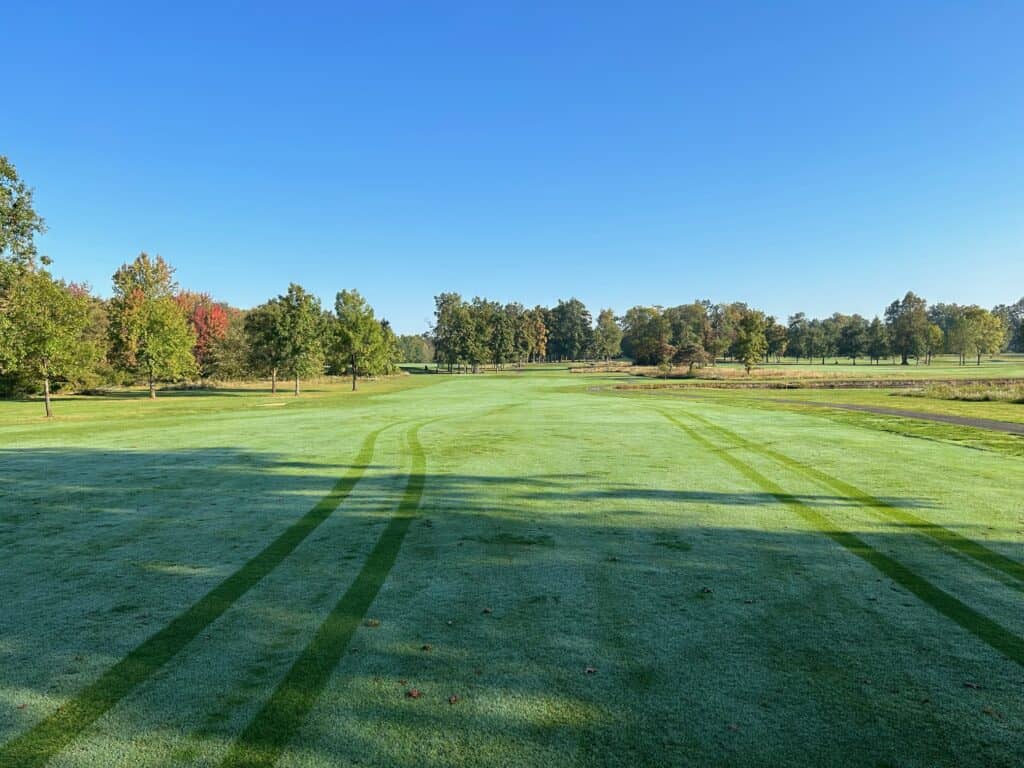
Introduction to Approach Shots in Golf
Golf is a game that requires precision and strategy. Approach shots are the shots played from the fairway or rough to the green. These shots are crucial as they determine the player’s ability to place the ball close to the pin and set up a potential birdie or par. Mastering approach shots can significantly improve your game and lower your scores.
Golfers typically hit 18 approach shots in golf.
I would consider the tee shot on a par 3 an approach shot. On a par 4, it is typically the 2nd shot of a hole and on a par 5 the 3rd shot of a hole. Being able to dial in your distance and control your start line can help take your game and your scoring to the next level.
Understanding the Importance of Approach Shots
Approach shots are often the key to scoring well in golf. It is during these shots that players have the opportunity to position the ball close to the pin, giving them a better chance to make an easy putt. The ability to hit accurate approach shots can make a significant difference in the outcome of a round. By mastering approach shots, you can increase your chances of scoring lower and achieving your golfing goals.
Common Mistakes to Avoid in Approach Shots
Approach shots can be challenging, and many golfers make common mistakes that hinder their performance. The biggest mistake we see amateurs make is picking the wrong target, often times too aggressive. The 2nd biggest mistake we see is not taking enough club and overestimating how far one actually hits their irons.
Another common mistake is failing to account for wind and other environmental factors that can affect the trajectory and distance of the ball. It is crucial to assess the wind direction and speed before making your shot and adjust your aim accordingly.
Finally, another mistake is overcomplicating the swing. Keep your swing simple and controlled, focusing on making clean contact with the ball. Finally, avoid rushing your approach shots. Take your time to assess the situation, choose the right club, and visualize the shot before executing it.

10 Tips To Improve Your Approach Shots
Tip #1: Dial in Your Distances
Distance control is crucial in approach shots, as it determines the landing position of the ball on the green. One strategy for distance control is to focus on tempo and rhythm to ensure consistent ball striking and speed through your swing. A smooth and controlled swing will help you generate consistent distances with each club.
However, the most important thing you can do is to chart the distance that you hit each iron in your bag. Be realistic and honest with yourself. We recommend using technology to help you dial in your distance by mapping you bag.
We use a Skytrak to dial in our distance. Our process looks like this:
- Hit 10 shots with each iron in the bag
- Eliminate any outliers in these numbers (too far or too short)
- Go ahead and calculate your averages
- Create a chart like the one below.
| Club | Carry Distance (100%) | 90% | 80% |
| 2 Utility Iron | 220 | ||
| 4 iron | 197 | ||
| 5 iron | 187 | ||
| 6 iron | 178 | ||
| 7 iron | 169 | ||
| 8 iron | 159 | ||
| 9 iron | 150 | ||
| P Club | 140 | 128 | 116 |
| Pitching Wedge | 130 | 119 | 109 |
| SW Club | 117 | 97 | 91 |
| LW Club | 94 | 82 | 74 |
Tip #2: Create A Stock Shot
A stock shot is a go to shot pattern that you can count on. Whether this is a draw or fade it doesn’t really matter. The key is that you can hit this shot shape on demand. Too many golfers spend time trying to hit both, when in reality, most amateurs simply need one shot shape.
I hit a stock draw with my irons and a stock fade with my driver.
Why do you want to hit a stock shot? You want your ball curving towards the hole. This means starting the ball right of your target line with a draw or left of the target line with a fade. This allows your golf ball to play “offense” as it is approaching the green. This can also help your eliminate the two sided miss and manage your game properly.
Here is a drill to create a stock shot:
- At the driving range, set up an alignment stick about 6-8 yards in front of you, straight down your target line.
- If you have a second alignment stick, set the stick 3-4 yards right of the first stick (for a draw) or left of the first stick (for a fade).
- Complete your initial assessment see how many times out of 10 you can start the ball to the right or left of your target. Pick one side and measure your game at this point.
- The goal is to eventually get 7 out of 10 shots to start to the correct side and draw back towards the target.
Tip #3: Pick Quality Targets
Too often amateur golfers just simply aim right at every pin.
This can lead the golfer to short siding themselves and leaving difficult chip shots. Over enough holes, not playing the percentages will cost you shot after shot. Instead, pick a conservative target and make an aggressive swing. This allows you to play with confidence and not play scared. Overtime, you will hit some shots close and if not leave yourself with a reasonable 20-40 foot putt.
- Did you know? The proximity to the pin from 100 yards on the PGA Tour is 18 feet.
- Did you know? The proximity to the pin from 150 yards on the PGA Tour is 25 feet.
- Did you know? The proximity to the pin from 200 yards on the PGA Tour is 41 feet.
Keep these stats in mind and keep calm if you hit it to 30 feet from 100 yards and go ahead and make sure at worse your two putt.
These stats will also help you pick reasonable targets and manage your approach shots.
Tip #4:Use Technology
In tip 1, we shared the importance of knowing how far you hit each club. The next key is to know the distance you have left to different locations on the green.
We recommend knowing the following distance:
- Front of Green Distance
- Middle of Green Distance
- Back of Green Distance
- Pin Distance
The golfer can gain these distance from two different devices:
- GPS Watch
- Rangefinder
While I use both during my round, if I had to only pick one, I would go with the GPS watch. The front, middle and back distances should be good enough for many golfers. Of course, having a pin distance can help you further dial in your shot and your club selection.
I have also used the Arccos Sensors to further dial in my distance and the app that comes with the sensors is rather impressive and gives you carry distance over water hazards and bunkers, which is very helpful.

Tip #5:Understand Your Lie
Have you ever been in a light rough and sailed it over the green? You most likely caught a “flyer” lie and the spin rate was reduced, causing the ball to fly too far. Understanding your lie in golf is a key when you miss the fairways and are hitting an approach shot from the rough.
The best way to practice these various lies is a driving range where you can hit from a rough lie. Use a launch monitor to measure how far you hit certain lies and over time you develop a solid feel of what could happen.
Tip #6: Improve Your Low Point Control
The better you strike the ball, the better you will control your distances. The golfer that hits too many thin shots and fat shots will struggle with controlling their distance. There is a major gap in the scratch golfer compared to the 20 handicap when it comes to low point control. The best golfers are able to hit the ball solid over 99% of the time. Meanwhile, the high handicap golfer might only strike the ball solid around 50% of the time.
Drill to improve your low point control:
- Use yard pain and pain a 2-3 foot long line on your grass
- Using wiffle balls, try striking the ball on the target side of the line.
- Repeat and practice for several weeks in a row to dial in your low point control.
- If you are struggling to be consistent, try starting with 60% of the weight on your front leg and making a 3 quarter swing.
Tip #7: Consider the Elements
Is the green firm or soft? Is the wind blowing and if so in what direction? How is the ball carrying today? Is the weather cold or hot? How are you feeling that day – strong or weak?
The best golfers take these elements above into consideration. Learn to manage your game and be aware of the elements you are playing on that day.

Tip #8: Track Your Data to Monitor Improvement
How do you know if you are getting better? You have to find a way to monitor your improvement.
One option is to chart traditional stats such as Greens in Regulation. Another options is to walk off every approach shot where you hit the green and write down your proximity to the pin and calculate on your own. The best option and one that I started using in the 2023 season is the Arccos System, which measure your proximity to pin without doing much on the course other than marking the pin either on your apple watch or your phone as your enter every green.
The great thing about the Arccos App is that you can compare your shots to different level golfers. I like to compare myself to a scratch golfer and know that I gain around 2 shots per 18 holes with my approach shots compared to a scratch golfer. I have identified approach shots as the strongest part of my game. Now if I can get my putter dialed in, I can get below the scratch level.
Tip #9: Develop a 3 Quarter Shot
Having a go to shot that you can count on under pressure or when you have a less than full distance will be important as you try to reach new levels. Work on this comfortable 3 quarter shot where you set up with 60% of your weight on your frost side and ensure you make clean contact with impressive compression.
Tip #10: Practice and then Practice Some More!
I prefer to use my Skytrak in my golf simulator setup space. This allows me to hit plenty of realistic type shots at the great courses around the world including Augusta, Pebble, Whistling Straits, Le Golf National, etc.
What better way than to practice long irons than hitting into the 17th hole at Pebble or the mid irons at the 12th hole at Augusta! The feedback is immediate and you can know the exact carry distance immediately. This has helped me take my approach shots to new levels!

Conclusion and Next Steps to Master Approach Shots in Golf
Approach shots are an integral part of the game of golf. By understanding their importance and implementing the tips and strategies mentioned in this post, you can improve your approach shots and elevate your game. Remember to practice consistently and be patient with your progress.
Mastering approach shots takes time and dedication, but the rewards are well worth it. So, step onto the course with confidence, visualize your success, and watch as your approach shots become a strength in your golf game.